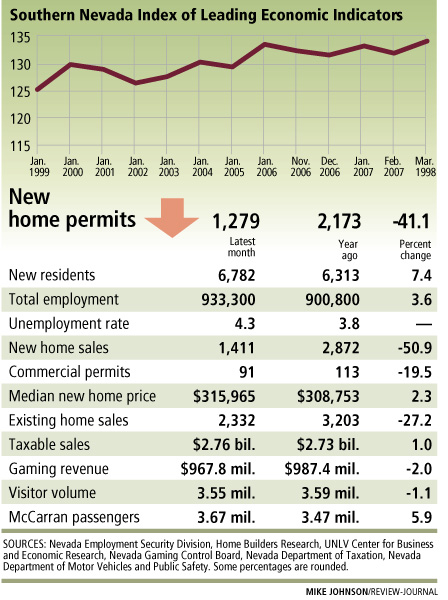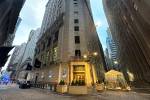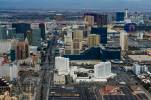LV Valley
Despite a downturn in construction activity, the Southern Nevada Index of Leading Economic Indicators ticked up to 133.17 in March, a local economist said Monday.
Seven of the 10 series contributed negatively to the index, which is compiled by the Center for Business and Economic Research at University of Nevada, Las Vegas.
Permitting activity showed sharp declines from robust levels of a year ago, with residential permits down 67.3 percent in January, the month of data used for the March index. Residential building permit valuation fell 64.8 percent to $260.8 million.
The number of commercial permits dropped 10.7 percent to 75 and commercial building valuation decreased 55.6 percent to $93.7 million.
The index, a six-month forecast from the month of the data, is up from 132.79 in February and dropped slightly from 133.30 in March 2006.
Keith Schwer, executive director of the research center, said the index categories are not evenly weighted, which is why more than half of the variables can be negative and the overall index shows positive movement.
The accompanying chart includes several of the index's categories, along with data such as new residents and employment and housing numbers, updated for the most recent month for which figures are available.
The recent rate of modest declines shows "insufficient momentum" to signal a recession, Schwer said.
"All in all, we believe the weakness in housing, which has to date not been passed on to other sectors with any veracity, will only push the trend in the economy to a slower growth trajectory," he said.
New home sales in Las Vegas slumped 50 percent in February, new home permits declined by more than 40 percent and existing home sales were off by 27 percent, Dennis Smith of Home Builders Research reported.
Southern Nevada's population continues to grow; the valley gained 6,782 new residents in February, up 7.4 percent from a year ago.
Nearly 33,000 jobs were added to the local economy over the past 12 months, a 3.6 percent increase in total employment. The unemployment rate rose to 4.3 percent from 3.8 percent a year ago.
"Because construction had been leading our job growth, when housing slowed, we saw the pace of job growth slow," said Jim Shabi, economist for the Nevada Department of Employment, Training and Rehabilitation.
Las Vegas leads the nation in employment growth and was running at about 7 percent a year ago, Shabi said. The construction industry has flattened out, but other industry sectors are still adding jobs, he said.
"We're in between building cycles on the Strip, with Palazzo and Wynn (Encore) and CityCenter on the way, so tourism job growth has also slowed, but it's holding its own," Shabi said.
The CBER Tourism Index posted a modest 1.29 percent growth rate in January from a year ago.
Only once in the past 12 months has the year-ago rate of change been negative in the tourism index, Schwer noted.




























